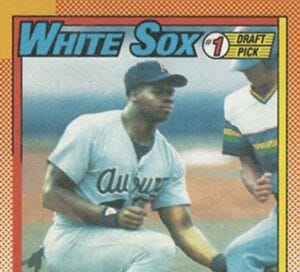The $122,000 Frank Thomas Rookie Card That Was Never Supposed to Exist
How a printing error turned cardboard into gold
In the world of sports cards, some grails are minted by greatness. Others are born by accident.
Today, we’re breaking down one of the most fascinating and sought-after error cards in the hobby’s history: the 1990 Topps Frank Thomas “No Name on Front” rookie card, better known as the NNOF.
It’s not just a printing mistake. It’s a six-figure legend that still captures the imagination of collectors 35 years later.
The Birth of a Cardboard Myth
In 1990, Topps was printing its flagship baseball set like clockwork. Frank Thomas, a power-hitting rookie out of Auburn, was slotted in at card #414.
Somewhere early in the production run, something went wrong.
A small number of cards came off the press missing Thomas’s name entirely. The current theory is that a strip of cardstock jammed into the printer, blocking the black ink layer from hitting certain parts of the sheet. The result was a clean image, team name, position, and border—but no name.
Most printing errors are discarded, overlooked, or written off as oddities. This one became a legend.
Impossible Odds
The 1990 Topps NNOF wasn’t inserted into factory sets. It was only included in early-run wax boxes before the mistake was caught.
You can technically still pull one, but don’t get your hopes up. A well-known collector once estimated that you’d need to open one pack every minute for a year and a half to have a reasonable shot at finding one.
Most collectors who find one today do so through sheer luck, high-risk wax rips, or private sales.
By the Numbers
To understand just how rare this card is, here’s a snapshot from the grading world:
PSA has graded only 437 copies of the NNOF
By comparison, over 29,000 standard 1990 Topps Frank Thomas rookie cards have been graded
A BGS 8 NNOF sold for $122,000 just a few weeks ago
The lowest recorded sale is a PSA 5 that went for $351.99 back in 2006
There is only one PSA 10 on record
While junk wax-era cards are mostly viewed as mass-produced commodities, the NNOF stands out as a unicorn. Its scarcity, mystery, and story give it lasting value in a sea of overproduction.
How to Spot a Real One
Given the card’s value, counterfeits are inevitable. But there are a few key ways to separate the real ones from the fakes.
Authentic copies have a small black dot just under Thomas’s shoulder
Card stock and print quality should match other 1990 Topps cards exactly
Centering, color saturation, and ink application should be consistent with the rest of the sheet
When in doubt, buy only graded examples or submit raw cards to PSA or BGS for authentication
Buying an ungraded NNOF without experience is like buying a Rolex from Craigslist. The risk outweighs the reward.
Not Just Frank
The NNOF wasn’t an isolated error. Because the issue stemmed from a print sheet defect, several other players on the same sheet show partial black ink losses. Craig Biggio, Jim Acker, John Morris, and John Hart cards have surfaced with similar issues, though none carry the prestige or price of the Thomas card.
Collectors have begun to hunt these down as part of the “blackless” variant chase, trying to piece together what else Topps quietly fumbled on that day.
The Legacy
So why does this card matter?
Because it represents what makes collecting special. Not just scarcity, but story. Not just value, but mystery. It’s not the most beautiful card ever printed, and it’s certainly not the rarest. But it is a perfect storm of timing, talent, error, and enduring curiosity.
In 2025, Topps released a 35th-anniversary tribute insert in honor of the NNOF. That alone tells you what this card means to the hobby.
The Sports Card Prospectus Take
Opening 1990 Topps packs to chase an NNOF is a bad investment. But buying one? That’s a different story.
If you’re building a portfolio of iconic, culturally relevant sports cards, the NNOF belongs near the top. It is one of the few cards from the overproduced junk wax era that defies its surroundings and holds true grail status.
For serious collectors, it’s a museum piece. For investors, it’s a blue-chip with a track record. For the rest of us, it’s a reminder that even in the most saturated markets, magic still slips through the cracks.
This card should not exist. And that’s what makes it so valuable.



